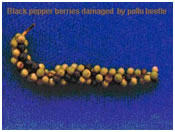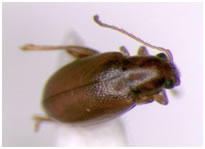Crop Protection :: Pepper
Pollu beetle: Longitarsus nigripennis
| Symptoms of damage: |
- Grub feeds on the growing tip, tender stem, leaf petiole, spikes and berry.
- Tunneling of tender stem causes drying up of the shoot.
- The portions of the spikes tunneled by grubs turn black and cause dropping of spikes due to the subsequent rotting.
- Grubs bore into the berries and feed on entire internal contents.
- Exit holes could be seen on dry berries.
- As a result of grub boring, the berries dry up and turn dark in colour.
- They are hollow and crumble when pressed.
- Such hollow berries are called ‘Pollu’ berries.
|
Leaf damage:
- The adult beetles feed on all stages of the leaves.
- Most preferred one is tender leaves.
- Due to feeding irregular holes are seen.
- On mature leaves, the beetle scrapes the green matter leaving the layer of upper epidermis.
|
 |
 |
Berry damage |
Leaf damage |
|
| Identification of pest: |
Eggs
- Female beetle scoops out shallow holes on growing bud, leaf, petiole, terminal buds, spikes and tender berries and lay eggs singly.
- Freshly laid eggs are yellow and turn brownish yellow.
- Grubs: Pale yellowish in colour.
- Pupa: Pupation takes place in the soil in an earthen cell
- Adult: Beetle is oblong with shiny black elytra and enlarged hind femur
|
 |
| Adult |
|
| Management: |
- Regulation of shade in the plantation reduces the population of the pest in the field.
- Tilling the soil at the base of the vines at regular intervals
- Spraying quinalphos (0.05% each) during June/July and September/October or quinalphos (0.05% each) during July and Neemgold (0.6%) (neem-based insecticide) during August, September.
- The undersides of leaves (where adults are generally seen) and spikes are to be sprayed thoroughly
|
|
